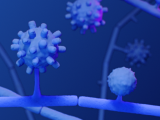Nov 9, 2012
CDC pinpoints peanut butter product in Salmonella outbreak
State health officials have isolated the Salmonella Bredeney outbreak strain in peanut butter sold at Trader's Joe's in an investigation of an outbreak that has now grown to 41 cases in 20 states, the Centers for Disease Control and Prevention (CDC) announced yesterday. Investigators from New Jersey, Virginia, and Washington found the outbreak strain in opened jars of Trader Joe's Valencia Creamy Peanut Butter with Sea Salt collected from patients' homes, the CDC reported. The peanut butter was made by Sunland Inc. of Portales, N.M., which has recalled hundreds of products since the outbreak surfaced in September. The new case count is three higher than in the previous CDC update on Oct 24, with the latest cases in New York, North Carolina, and Virginia. Among 36 people with available information, 10 were hospitalized. Sixty-three percent of the patients have been children under 10, and illness onset dates ranged from Jun 14 to Sep 21. The CDC said the incidence of cases has declined, but the outbreak could continue for months if consumers are unaware of the Sunland recalls.
Nov 8 CDC update
Fungal meningitis outbreak grows to 438 cases
Fourteen more infections and one death have been reported in a multistate fungal meningitis outbreak linked to contaminated steroid injections, the CDC said today. The new cases raise the outbreak total to 438 illnesses, 32 of them fatal. The number of affected states remained at 19, and the number of peripheral joint infections linked to tainted methylprednisolone acetate from New England Compounding Center stayed at 10. So far Exserohilum rostratum, a type of black mold, has been confirmed in clinical specimens from 75 patients. Only one patient—the index case—had a lab-confirmed Aspergillus fumigatus infection. The CDC said it is aware of reports of spinal epidural abscess and arachnoiditis complications in a number of patients being treated for fungal meningitis infections. It added that most of the early reports are from patients in Michigan and Tennessee, but other states are reporting the conditions as well.
Nov 9 CDC update
US, global flu activity remains low
US influenza activity increased in some areas but overall remained at the same low levels as last week, the Centers for Disease Control and Prevention (CDC) said today. The proportion of outpatient visits attributed to influenza-like illness (ILI) was 1.3%, which is below the national baseline of 2.2%, and all 10 regions reported ILI below their baseline levels. Louisiana reported low ILI activity; while the rest of the country experienced minimal ILI activity. Maine reported regional geographic spread of influenza, 8 states saw local activity, 33 states reported sporadic activity, and 8 states had no activity. During the week ending Nov 3, the proportion of patients' deaths due to pneumonia and flu was 6.6%, compared with a national baseline of 6.5%. No pediatric deaths were reported.
Nov 9 CDC update
Globally, flu activity remains low throughout the temperate North Hemisphere, with a slight uptick in virus detections but none crossing the epidemic threshold, the World Health Organization (WHO) said today in an update. The agency added that Nicaragua and Costa Rica reported an increase in mainly influenza B and that India, Sri Lanka, Nepal, and Cambodia are reporting circulation of all three virus subtypes: pandemic 2009 H1N1 (pH1N1), H3N2, and influenza B.
Nov 9 WHO update
The European Centre for Disease Prevention and Control (ECDC) said today that all 26 reporting countries are seeing low flu activity, and that only 2 of 279 sentinel specimens from 19 countries were positive for flu. The agency also released a report today summarizing flu virus characteristics in Europe so far this year. It says that H3N2 viruses have predominated, and that pH1N1 viruses continue to exhibit genetic drift from the vaccine strain, "but the vast majority remain antigenically similar to it."
Nov 9 ECDC weekly update
Nov 9 ECDC report on virus characteristics
West Nile virus may be attacking the brain more aggressively
The West Nile virus (WNV) responsible for more than 5,000 US cases this year may be attacking the brain more aggressively than previous years' strains, according to a Washington Post story yesterday. Two neurologists and WNV experts—Art Leis, MD, of Jackson, Miss., and Elizabeth J. Angus, MD, of Detroit's Henry Ford Hospital—said the cases they've seen raise the possibility that the virus has mutated. Leis has seen more damage in the parts of the brain that control speech and thought, and Angus has observed brain damage in young, previously health patients, which she hadn't seen before. "For the first time, we have radiographic evidence, clinical evidence of the virus attacking the higher cortical areas," said Leis, who added that 11 of the first 12 patients he saw this year at the Methodist Rehabilitation Center in Jackson had more severe brain damage than in previous years. "I've been struck this year that I’m seeing more patients where the brain dysfunction has been very much worse," Angus commented. A CDC scientist said the agency hasn't noted this difference but acknowledged that the CDC does not collect the in-depth data needed to make this observation.
Nov 8 Washington Post story



















